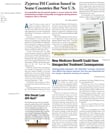About 15 percent of adolescents who attempt suicide unsuccessfully try again within six months, and repeat attempts increase the risk of completed suicide, so treatments that reduce that rate are critical. A new study found little difference between two such treatment protocols but retained most patients in treatment through the six-month trial.
“When adolescents who attempt suicide are maintained in treatment, significant improvements in functioning can be realized for the majority of patients,” wrote Deidre Donaldson, Ph.D., Anthony Spirito, Ph.D., and Christianne Esposito-Smythers, Ph.D., in the February Journal of the American Academy of Child and Adolescent Psychiatry.
“This is a small study, serving more as a proof-of a concept, to make you think rather than to draw conclusions,” said David Brent, M.D., M.S.Hyg., a professor of psychiatry at the University of Pittsburgh's Western Psychiatric Institute, in an interview.
While the outcome of a small trial may not seem dramatic, it can be helpful because there are so few randomized, controlled trials in any population of adolescents following suicide attempts, he said.
The researchers randomized 39 adolescents aged 12 to 17 years to either a skills-based, cognitive-behavioral treatment using problem-solving skills and affect management or nondirective, supportive relationship treatment focusing on mood and behavior. Baseline and outcome statuses were measured with the Diagnostic Interview Schedule for Children, Suicide Ideation Questionnaire, Center for Epidemiologic Studies-Depression Scale, State-Trait Anger Expression Inventory, Social Problem Solving Inventory–Revised, and the Means-End Problem-Solving Procedure.
Thirty-two of the young people were girls, and 33 were white. About half were on medication prescribed by a physician. Of those, 50 percent were taking an SSRI alone, 33 percent an SSRI plus another medication, 11 percent a mood stabilizer, and 6 percent an atypical antidepressant.
“This is a population we need to know more about because adolescents who have attempted suicide are usually excluded from clinical trials,” said Brent. “It's important to show that you can engage them in a clinical manner.”
Patients in both arms of the trial met with trained therapists in six individual sessions and one adjunct family session during the first three months. This was followed by monthly sessions over the next three months. Therapists could add two more family sessions and two crisis sessions if needed.
Of the 39 patients who started the trial, 31 were available for follow-up evaluation. There were no significant differences between study participants who completed the trial and those who dropped out, said the authors.
Study outcomes at six months showed no statistically significant differences between the skills-based and supportive treatments, including the rate of reattempts, said the researchers. Six adolescents (four of 15 in the problem-solving arm and two of 16 in the supportive group) attempted suicide during the six-month trial, none successfully.
About three-quarters of the participants reduced their suicidal ideation or remained in the nonclinical range at the three-, six-, and 12-month assessments. Participants in both arms showed significant improvements in depressed mood, suicidal ideation, and problem solving.
While the rate of reattempts was similar to those in other studies, the researchers were encouraged that 31 of 39 participants (approximately 80 percent) completed the trial.
“Retention rates in this study were relatively high across conditions, contrary to previous findings,” they reported.“ Treatment appeared to work well for most adolescents, so they chose to complete the protocol.”
The researchers attributed this to compliance-enhancement strategies developed in their previous research, fewer access barriers to treatment (such as long waiting lists or inflexible scheduling), and therapists who had small caseloads and thus could devote time and attention to keeping the subjects in the study.
Engaging adolescent suicide attempters with a brief course of psychotherapy and eliminating barriers to care could help these patients, the researchers said. In the future, larger trials could increase the power to detect differences in low-frequency, high-risk outcomes. Other research paths might yield useful therapeutic directions, too, said Brent.
“If you think problem solving is a variable, then you might try for a bigger study,” he said. “But what might also be useful are small studies using more proximate variables, like hopelessness, suicidal ideation, or depression. The more things you can study that are more closely related to the outcome, the stronger the case you can make.”
The study, “Treatment for Adolescents Following a Suicide Attempt: Results of a Pilot Trial,” is posted online at<www.jaacap.com/pt/re/jaacap/fulltext.00004583-200502000-00003.htm>.▪
